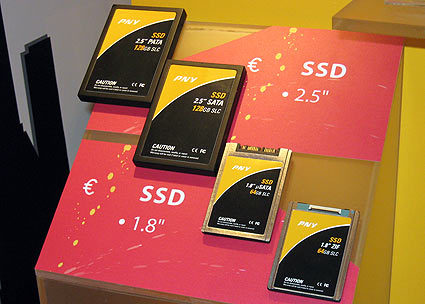Computex 2007 Summary
Flash Drives To Replace Hard Disk Drives?
We've seen lots of Flash memory based hard drives between 8 GB and 256 GB, and it seems as if their manufacturers are trying to beat each other with higher capacity points and performance numbers. But the really interesting capacities are still way out of range for most users.
Nearly every memory manufacturer and memory vendor sees the potential of non-volatile Flash memory as a replacement for conventional hard drives. When configured in multiple channels, Flash memory can provide data transfer rates that at least match those of a 2.5" disk drive, with access time that is virtually nonexistent. Although Flash memory wears off through use, it is much more robust than a mechanical hard drive. However, Flash is still clearly more expensive from a cost per gigabyte standpoint, and we believe it won't compete with 3.5" drives any time soon.
We expect the first 16 and 32 GB hard drives to be available only weeks after Computex. These are a promising replacement for hard drives in the ultra-portable and high-end notebook space. However, even the 32 GB version might not be available for less than $300, and 64 GB models will be at least twice as much. We believe it will still be a few years until a Flash hard drive can finally attack conventional hard drives in the mainstream.
For the time being, Samsung and Seagate will be releasing the first hybrid hard drives, which are conventional 2.5" drives with an additional 256 MB or 512 MB Flash memory to store Windows and application information under Vista, so the OS and applications can launch more quickly. Flash is on its way, but hybrid drives will have to pave the way.
Innovate Or Customize?
Some companies, such as Coolermaster, are not only focusing on products with high value, they also spend quite some effort to offer highly customized products for those who simply want something different.
The IT hardware industry has been showing one characteristic for several years now: there are a few innovators, and lots of implementers. Think of an Intel chipset, Nvidia graphics or even an entire notebook: there usually is one company developing or designing, and a dozen manufacturers embracing the product to bring it to the market, sometimes giving it their own interpretation. Although this is necessary to meet the market demands, there have been changes.
Several years ago, you could still consider a radically redesigned motherboard a real innovation, because it offered features that were never intended by the platform inventors. Think of overclocking, on-board components, adjustable parameters such as memory timings or fan speeds, active vs. passive cooling and so on. Today, innovation is still possible, but due to strict specifications, it is increasingly being replaced by customization. Most AMD/ATI or Nvidia graphics cards are typically based on the creators' reference design, because the efforts required to increase performance are out of all proportion to the possible results.
Get Tom's Hardware's best news and in-depth reviews, straight to your inbox.
Current page: Flash Drives To Replace Hard Disk Drives?
Prev Page Speakers Go Bluetooth Next Page Pimp My CoolerTom's Hardware is the leading destination for hardcore computer enthusiasts. We cover everything from processors to 3D printers, single-board computers, SSDs and high-end gaming rigs, empowering readers to make the most of the tech they love, keep up on the latest developments and buy the right gear. Our staff has more than 100 years of combined experience covering news, solving tech problems and reviewing components and systems.


